
Rattus is a genus of muroid rodents, all typically called rats. However, the term rat can also be applied to rodent species outside of this genus.

The genus Brachylophus consists of four extant iguanid species native to the islands of Fiji and a giant extinct species from Tonga in the South West Pacific. One of the extant species, B. fasciatus, is also present on Tonga, where it has apparently been introduced by humans.

The Polynesian rat, Pacific rat or little rat, known to the Māori as kiore, is the third most widespread species of rat in the world behind the brown rat and black rat. The Polynesian rat originated in Southeast Asia, and like its relatives, has become widespread, migrating to most of Polynesia, including New Zealand, Easter Island, and Hawaii. It shares high adaptability with other rat species extending to many environments, from grasslands to forests. It is also closely associated with humans, who provide easy access to food. It has become a major pest in most areas of its distribution.

The Guam rail is a species of flightless bird, endemic to the United States territory of Guam. The Guam rail disappeared from southern Guam in the early 1970s and was extirpated from the entire island by the late 1980s. This species is now being bred in captivity by the Division of Aquatic and Wildlife Resources on Guam and at some mainland U.S. zoos. Since 1995, more than 100 rails have been introduced on the island of Rota in the Commonwealth of the Northern Mariana Islands in an attempt to establish a wild breeding colony. Although at least one chick resulted from these efforts, feral cat predation and accidental deaths have been extremely high. In 2010, 16 birds were released onto Cocos Island, with 12 more being introduced in 2012. In 2019, the species became only the second bird after the California condor to be reclassified by the IUCN from extinct in the wild to critically endangered.

Maclear's rat is an extinct large rat endemic to Christmas Island in the Indian Ocean. It was one of two species of rat native to Christmas Island, alongside the bulldog rat. Abundant, unfamiliar with and seemingly unafraid of humans, large numbers of the creatures emerged and foraged in all directions at night. Making querulous squeaks, the rats entered the Challenger Expedition's tents and shelters in 1886, ran over sleepers, and upset everything in the search and fight for food. Maclear's rat might have been responsible for keeping the population of the Christmas Island red crab in check, as recent numbers of the crab are greater than in the past. It is thought that black rats inadvertently introduced by the expedition infected the Maclear's rats with a disease, which in turn could have contributed to the species' decline. The last recorded sighting was in 1903, although it is possible that Maclear's rats hybridized with black rats. A hard tick, described as an ectoparasite of Maclear's rat, is also thought to be extinct.

The Mona ground iguana is a rock iguana that is a subspecies of the rhinoceros iguana. It is endemic to Mona Island, Puerto Rico and is the largest native terrestrial lizard in Puerto Rico.

The Lau banded iguana is an arboreal species of lizard endemic to the Lau Islands of the eastern part of the Fijian archipelago. It is also found in Tonga, where it was probably introduced by humans. It is one of the few species of iguanas found outside of the New World and one of the most geographically isolated members of the family Iguanidae. Populations of these iguanas have been declining over the past century due to habitat destruction, and more significantly, the introduction of mongoose and house cats to the islands.

The Jamaican iguana is a large species of lizard in the family Iguanidae. The species is endemic to Jamaica. It is the largest native land animal in Jamaica, and is critically endangered, even considered extinct between 1948 and 1990. Once found throughout Jamaica and on the offshore islets Great Goat Island and Little Goat Island, it is now confined to the forests of the Hellshire Hills.
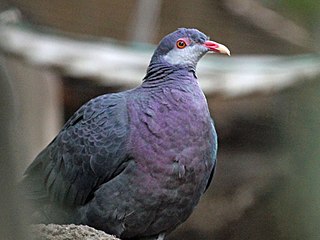
The metallic pigeon, also known as white-throated pigeon is a medium-sized, up to 37 cm long, bird in the family Columbidae.

The rhinoceros iguana is an endangered species of iguana that is primarily found on the Caribbean island of Hispaniola, shared by Haiti and the Dominican Republic. The largest of the Cyclura, they vary in length from 60 to 136 centimetres, and skin colours range from a steely grey to a dark green and even brown. Their name derives from the bony-plated pseudo-horn or outgrowth which resembles the horn of a rhinoceros on the iguana's snout.

The mangrove finch is a species of bird in the Darwin's finch group of the tanager family Thraupidae. It is endemic to the Galápagos Islands. It was found on the islands of Fernandina and Isabela, but recent surveys have failed to record the species on Fernandina. It has been classified as critically endangered by BirdLife International, with an estimated population of between 60 and 140 located in two large mangroves on Isabela. A study has shown that the two small populations remaining on Isabela Island have begun undergoing speciation and that one or both populations will eventually become extinct due to a lack of interbreeding.
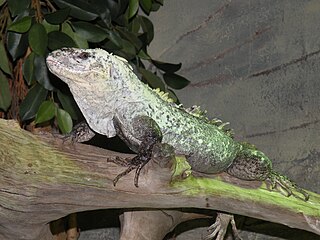
Ctenosaura bakeri, also known as the Utila iguana, Baker's spinytail iguana, swamper or wishiwilly del suampo, is a critically endangered species of spinytail iguana endemic to the island of Utila, one of the Islas de la Bahía off the coast of Honduras.

The Fiji crested iguana or Fijian crested iguana is a critically endangered species of iguana native to some of the northwestern islands of the Fijiian archipelago, where it is found in dry forest.
The palm rat is a species of rodent in the family Muridae. It is found only in the Nicobar Islands, on Car Nicobar and Great Nicobar islands.

The collared lory is a species of parrot in the family Psittaculidae, and it is the only species in the genus Phigys. It is endemic to the islands of Fiji. It is the only Fijian rainforest bird to adapt to urban landscapes and can be found in urban Suva. Measuring 20 cm (7.9 in), it has bright red underparts and face with a purple crown and greenish upperparts. Males and females are similar in plumage, although the latter have a paler crown.

The Cuban rock iguana, also known as the Cuban ground iguana or Cuban iguana, is a species of lizard of the iguana family. It is the largest of the West Indian rock iguanas, one of the most endangered groups of lizards. A herbivorous species with red eyes, a thick tail, and spiked jowls, it is one of the largest lizards in the Caribbean.
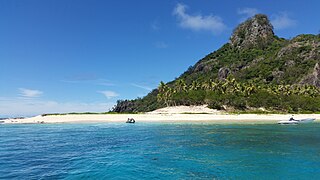
Monuriki is a small, uninhabited island situated off the coast of Viti Levu in the Fiji Islands, in Melanesia in the South Pacific Ocean. Monuriki is part of the Atolls islands, and related to a group of three islets in the larger group of islands of known as the Mamanuca Islands. This coral and volcanic island is the smallest islet and the southernmost of a small group of three islets, west of Tavua.
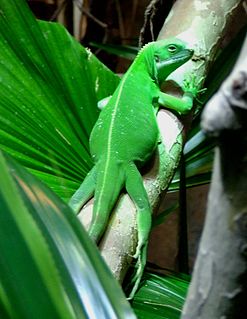
Brachylophus bulabula is a species of iguanid lizard endemic to some of the larger central and northwestern islands of Fiji, where it occurs in Fijian wet forest. It was described by a team led by a scientist from the Australian National University in 2008. It is one of the few species of iguana found outside of the New World and one of the most geographically isolated members of the family Iguanidae. Initially also reported from Gau Island, in 2017 this population was described as a separate species, B. gau.
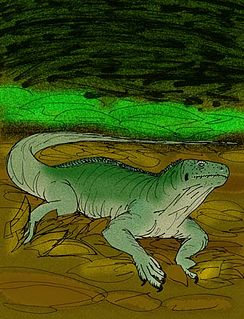
Brachylophus gibbonsi is an extinct species of large iguanid lizard from Tonga in the South Pacific Ocean. Its remains have been found associated with cultural sites on Lifuka, four other islands in the Haʻapai group, and Tongatapu. It was consumed by the early Tongans and probably became extinct within a century of human colonization of the archipelago 2800 years ago.

The Fiji tropical moist forests is a tropical moist forest ecoregion in Fiji and Wallis and Futuna. It covers the windward sides of Viti Levu and Vanua Levu, Fiji's largest islands, as well as the smaller Fijian islands and the three islands that make up Wallis and Futuna, an overseas territory of France.




















